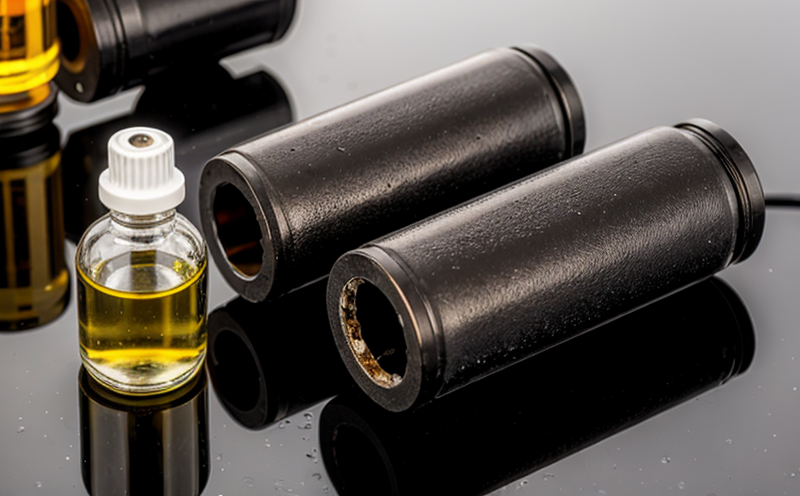APHA 5520B Oil and Grease Partition Gravimetric Test in Water
The APHA 5520B test is a widely recognized gravimetric method for the determination of oil and grease partitioned into water. This method is essential in environmental monitoring, particularly when assessing the impact of hydrocarbons on aquatic ecosystems. Compliance with this standard ensures that industries adhering to stringent water quality regulations can accurately quantify the concentration of petroleum products in wastewater.
The primary focus of APHA 5520B lies in partitioning oil and grease from a water sample into two phases: an organic phase (extracted using hexane) and an aqueous phase. The organic phase, which contains the hydrocarbons, is then separated and dried under controlled conditions to determine its weight. This approach allows for precise measurement of both dissolved and suspended oil and grease in water.
The test method is based on the principle that certain hydrocarbon compounds are soluble in hexane while others remain in the aqueous phase. By using this partitioning technique, APHA 5520B provides a robust means to assess the total petroleum-like hydrocarbons (TPHC) present in water samples.
The procedure involves several critical steps, including:
- Preparation of hexane and methanol solutions
- Sampling of the water matrix
- Extraction of oil and grease using hexane
- Drying of the organic phase under controlled conditions
- Weighing of the dried extract to determine the total weight of oil and grease
The accuracy of this method is enhanced through strict adherence to ISO 16040-2, which provides guidelines for the determination of hydrocarbons in water. This international standard ensures that laboratories conducting APHA 5520B tests maintain consistent results across different facilities and jurisdictions.
Quality managers and compliance officers rely on accurate oil and grease testing to ensure environmental standards are met. R&D engineers also benefit from this method, as it provides reliable data for developing new products or processes that minimize hydrocarbon emissions into water systems.
The importance of APHA 5520B cannot be overstated in ensuring the protection of aquatic life. By accurately quantifying oil and grease in water samples, this test helps prevent contamination of rivers, lakes, and oceans, thus supporting sustainable environmental practices.
Moreover, the results from this test are crucial for regulatory compliance. Industries such as petrochemicals, refineries, and waste treatment facilities must adhere to strict limits on hydrocarbon emissions into wastewater. APHA 5520B provides a reliable method for monitoring these parameters and ensuring that operations remain within legal boundaries.
The precision of the test is further enhanced by its ability to differentiate between dissolved and suspended oil and grease fractions in water samples. This capability allows for a more comprehensive understanding of the hydrocarbon contamination in various aquatic environments, enabling targeted remediation efforts where needed.
Scope and Methodology
The APHA 5520B test is designed to determine the amount of oil and grease partitioned into water using a gravimetric method. This involves extracting hydrocarbons from water samples with hexane, separating them from the aqueous phase, and drying the organic phase before weighing it. The method is applicable to both surface waters and wastewater.
The test procedure begins by preparing hexane and methanol solutions according to ISO 16040-2 guidelines. A representative sample of water is then taken, ensuring that it represents the entire water body or treatment facility being analyzed. The sample is allowed to settle if necessary before proceeding with the extraction process.
The oil and grease are extracted from the water using hexane, which dissolves both dissolved and suspended hydrocarbons. After extraction, the organic phase is separated and dried in an oven at 103°C ± 2°C for a period of 48 hours. This drying step ensures that all moisture has evaporated, leaving only the oil and grease.
The dried extract is then weighed accurately to determine its total weight. The results are reported as milligrams per liter (mg/L) or parts per million (ppm), depending on the regulatory requirements of the jurisdiction in which the test is being conducted.
For industries that produce wastewater, compliance with APHA 5520B is critical for maintaining environmental standards and avoiding potential fines. The method’s ability to differentiate between dissolved and suspended fractions provides valuable insights into the sources and types of hydrocarbon contamination present in water samples.
Benefits
The benefits of conducting APHA 5520B oil and grease partition gravimetric tests are numerous, particularly for industries that generate significant amounts of wastewater. These tests provide accurate and reliable data on the concentration of hydrocarbons in water samples, enabling better decision-making regarding environmental protection and regulatory compliance.
Firstly, APHA 5520B helps ensure that industrial operations remain within legal limits by accurately measuring oil and grease levels in wastewater. This is crucial for preventing contamination of aquatic ecosystems and avoiding potential fines from regulatory bodies.
Secondly, the test allows for targeted remediation efforts by identifying specific sources of hydrocarbon contamination. By differentiating between dissolved and suspended fractions, laboratories can pinpoint areas where improvements are needed to reduce hydrocarbon emissions into water systems.
Thirdly, APHA 5520B supports sustainable environmental practices by providing a reliable method for monitoring the effectiveness of pollution control measures. This helps ensure that industries contribute positively to environmental conservation efforts.
Fourthly, the test enhances operational efficiency through improved process control. By regularly analyzing water samples using this method, companies can identify and address issues before they escalate into larger problems. This proactive approach leads to reduced downtime and lower overall costs associated with environmental compliance.
Additionally, APHA 5520B supports research and development initiatives aimed at minimizing hydrocarbon emissions from industrial processes. The precise data provided by this test allows scientists and engineers to develop new technologies or modify existing ones that reduce the amount of oil and grease entering water systems.
Finally, compliance with international standards such as ISO 16040-2 adds credibility and reliability to laboratory results. This is particularly important for multinational corporations operating in multiple countries, where uniformity in testing protocols is essential for consistent performance across different regions.





